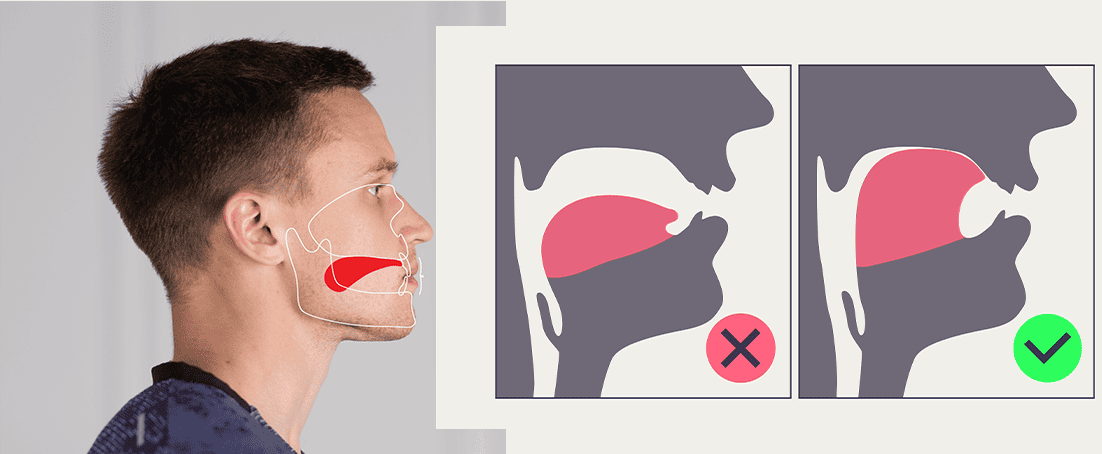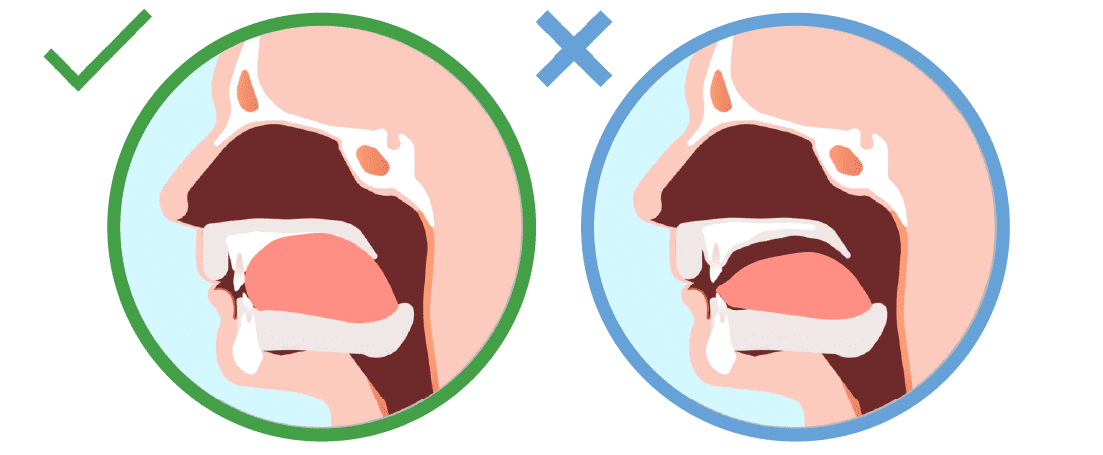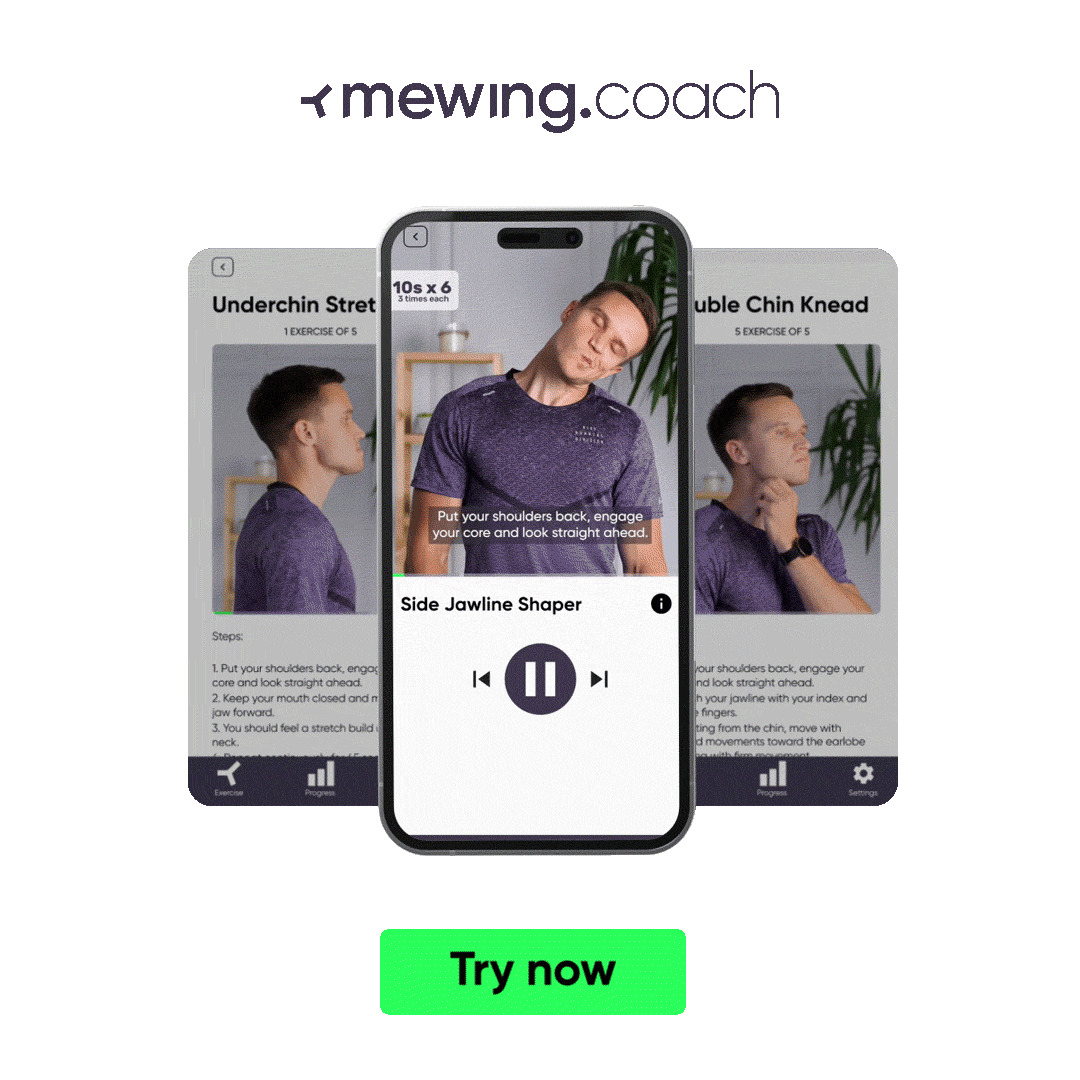
Proper tongue position is the cornerstone of mewing, a practice often misunderstood and cluttered with falsehoods. This complexity is amplified by the fact that, unlike in other physical exercises, you can’t visually confirm your technique. You can’t look in a mirror or get real-time feedback from an instructor to see if you’re doing it correctly.
Or can you?
Mewing.coach app is all you need to achieve a proper tongue posture and get a chiseled jawline. This app will provide you with a personalized workout plan, daily exercises, video guides, tips, daily reminders, etc.
It will become your tongue exercising trainer giving you real-time feedback! Start with a quiz below!
This article will explain how to maintain the correct tongue posture to provide accurate and actionable mewing guidance.
Where Should Your Tongue Naturally Rest?
A natural tongue position is consistent with how our bodies are designed to function optimally. In anatomical terms, your tongue is a muscular organ with a vital role beyond aiding in speech and digestion. When your tongue is at rest, the natural position entails the tip of your tongue making contact with the roof of your mouth, situated just behind your front teeth.
This contrasts with the all-too-common but incorrect practice of letting the tongue lie low on the floor of the mouth. A proper tongue position serves multiple functions. It assists in proper breathing, aids in swallowing, and can even influence facial development over time.

Where Should Your Tongue Rest When Your Mouth Is Closed?
When your mouth is closed, your tongue should rest against the roof of your mouth, spanning from the tip to the back. When the mouth is open, the tongue has a tendency to drop, potentially disrupting proper airway function. In contrast, a closed mouth encourages the tongue to assume its natural, beneficial position against the roof of the mouth.
A closed-mouth posture is preferable because it promotes nasal breathing. Nasal breathing is superior because it filters and humidifies the air, which can contribute to better overall health. Adopting a closed-mouth posture not only assists in maintaining the natural tongue position and improves your jawline but also encourages healthier breathing habits.
Where Should Your Tongue Rest When Sleeping (At Night)?
During sleep, your tongue should rest in the same position as when awake – against the roof of your mouth. Tongue posture plays a significant role in the quality of your sleep and overall health. An incorrect tongue position can lead to snoring, sleep apnea, or disrupted sleep, impacting your well-being.
To relax your tongue while sleeping, focus on maintaining a closed-mouth posture. In a sleeping context, nasal breathing becomes even more critical. It not only maintains the proper tongue position but also maximizes the efficiency of your breathing cycles during sleep. This leads to better oxygenation, improving the quality of your sleep and general health.
Tongue Resting Tips for Specific Sleep Positions
Different sleep positions require slight modifications to maintain the correct tongue posture.
Sleeping on Your Back: This position makes it easier to keep your tongue against the roof of your mouth. It also aligns well with spinal health.
Sleeping on Your Side: The tongue tends to fall to the side when you’re in this position. Counter this by consciously pressing your tongue against the roof of your mouth before drifting to sleep.
Sleeping on Your Stomach: This is the least advisable position for maintaining tongue posture and overall spinal health. If you find yourself in this position, make an extra effort to press your tongue against the roof of your mouth.
The optimal sleep position for tongue posture is on your back. This position complements a closed-mouth posture, which facilitates superior nasal breathing.
For those finding it challenging to maintain a closed mouth, using mouth tape, nasal strips or similar appliances can be helpful. These products keep your mouth closed, making it easier to keep your tongue positioned correctly against the roof of your mouth.

Common Tongue Resting Problems
Perhaps the most prevalent tongue placement issue is the tongue dropping from the roof of your mouth during sleep. It can manifest as a dry mouth and bad breath upon waking. It also contributes to disrupted sleep cycles and can even induce sleep apnea symptoms.
Another frequent obstacle is difficulty pinpointing the correct spot on the roof of the mouth for the tongue to rest. The right position is crucial for maximizing the benefits of proper tongue posture, yet many find it elusive. That may be due to ingrained habits or a lack of awareness about the significance of tongue posture.
The complexity is complicated more by the inability to visually confirm tongue position, making it challenging to know if you’re doing it correctly. Unlike other body misalignments, such as back posture, we can not rely on others to remind us of bad posture or visually confirm when our positioning is good.
There’s also the issue of the mouth involuntarily opening during sleep, causing the tongue to fall from its position. This not only disrupts proper breathing but can lead to a host of dental issues like dry mouth and bad breath. For those who do manage to keep their mouths closed, the problem often shifts to the tongue instinctively resting on the floor of the mouth.
Ways to Fix Bad Tongue Resting Position
A good starting point to locate the proper tongue position is saying words like “Sing,” “King,” or “Ring.” This simple act naturally elevates the tongue to the correct spot on the roof of the mouth. Achieving this position permanently involves mewing exercises and techniques as well as orthodontic treatments, surgeries, and a lot of conscious practice.
Mewing
Mewing is the practice of maintaining a specific tongue posture against the roof of your mouth. It aims to provide various health benefits, including improved facial structure and better respiratory function. Here are three key techniques for effective mewing:
Spotting Technique: Say words like “Sing,” “King,” or “Ring” to find the natural resting position for your tongue. This technique helps your tongue gravitate toward the correct spot on the roof of your mouth. Make this a daily routine to habituate the correct tongue position.
Mewing Technique: First, close your mouth and keep your lips sealed. Your front teeth should sit slightly behind the upper ones without touching. Flatten your entire tongue against the roof of your mouth, pushing gently and evenly, and remember to leave a small gap between your front teeth and the tip of the tongue. Hold for 30 seconds, gradually increasing the duration.
Hard Mewing: This involves increasing tongue pressure against the palate in short bursts, pushing as hard as possible. Begin with five-second intervals and work your way up. This helps in strengthening the tongue and facial muscles.
Consistent practice of these tongue training techniques will help you achieve proper tongue posture, improving not just your facial appearance but also your overall health.
For daily practice, you can use the Mewing.coach app, which offers reminders and a dedicated mewing exercise plan. It is the most effective and quickest solution to the problem of bad tongue resting position.
Orthodontic Treatment
Orthodontic options such as braces and aligners offer a more structured approach to correcting tongue posture. These appliances work by realigning your teeth and jaws, which in turn helps in accommodating your tongue in its proper resting place.
Braces exert constant pressure on the teeth, guiding them into the desired positions over time. Aligners, which are generally transparent and removable, serve a similar purpose but offer more flexibility.
While the results often prove to be long-lasting and comprehensive, this is a lengthy and costly route. You will need numerous visits to a dentist and pay for multiple appliances. There are also some possible side-effects that are minimal if you pursue mewing instead.
Frenectomy (Surgery)
Frenectomy is a surgical procedure that addresses a condition known as tongue-tie or restrictive lingual frenulum. This condition limits the tongue’s range of motion, making it difficult to maintain the proper tongue posture. During a frenectomy, a surgeon cuts the restrictive tissue, freeing the tongue for a greater range of motion.
It is the most expensive option for correcting tongue posture but may be an effective solution for those suffering from severe tongue tie. This surgical option should be considered a last resort after exploring less invasive methods for improving tongue position.
Lifestyle Adjustments
Lifestyle changes are not just supplementary. They’re almost necessary for the success of other treatments. Simple changes such as avoiding mouth breathing and consciously maintaining nasal breathing can be essential.
Adopting an upright posture while sitting and walking, chewing gum, or using mouth tapes, can also make a significant difference. These adjustments cost nothing but commitment and complement (in some cases, even replace) other more intensive measures like Frenectomy (Surgery).
Myofunctional Therapy
Myofunctional therapy involves the guidance of a trained specialist to help you improve the posture and function of the facial muscles and tongue. It’s very similar to mewing but with the support of an expensive expert. In a typical session, a therapist will guide you through a series of exercises designed to improve your tongue positioning, breathing, and swallowing.
I recommend this route, particularly for those who lack confidence in their ability to learn proper tongue posture independently. While the therapy may come at a higher cost, it provides personalized guidance. However, mewing is not as complex as it looks, especially when using an app like Mewing.coach.
Frequently Asked Questions
Is It OK to Rest Your Tongue On The Bottom Of Your Mouth?
Resting your tongue on the bottom of your mouth is not ideal for optimal oral health and facial development. This position can lead to mouth breathing, poor jawline structure, and other health complications.
Should My Tongue Touch My Teeth When Resting?
Your tongue should not touch your teeth while at rest. Allowing it to do so can lead to tooth misalignment, crooked teeth, and other oral health issues.




